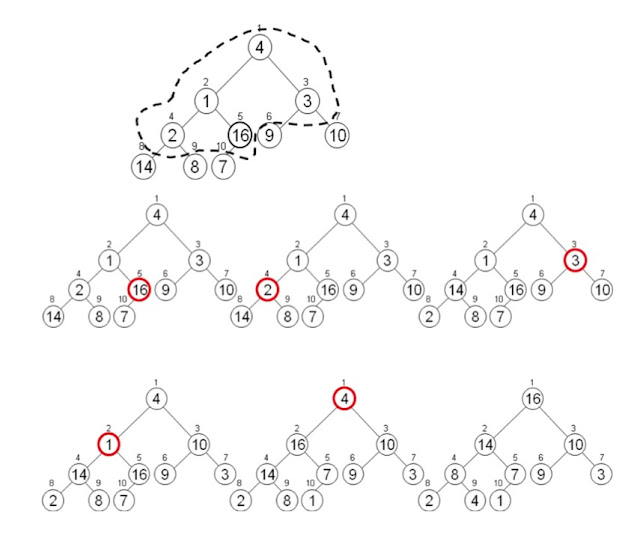Heap Sort
A heap is a nearly complete binary tree with the following two properties:
- Structural property: all levels are full, except possibly the last one, which is filled from left to right
- Order (heap) property: for any node x, Parent(x) ≥ x
Array Representation of Heaps
- A heap can be stored as an array A.
- Root of tree is A[1]
- Left child of A[i] = A[2i]
- Right child of A[i] = A[2i + 1]
- Parent of A[i] = A[ i/2 ]
- Heapsize[A] ≤ length[A]
The elements in the subarray A[(⌊n/2⌋+1) .. n] are leaves
Max-heaps (largest element at root), have the max-heap property:
- for all nodes i, excluding the root:
A[PARENT(i)] ≥ A[i]
Min-heaps (smallest element at root), have the min-heap property:
- for all nodes i, excluding the root:
A[PARENT(i)] ≤ A[i]
Adding/Deleting Nodes
New nodes are always inserted at the bottom level (left to right) and nodes are removed from the bottom level (right to left).
Operations on Heaps
- Maintain/Restore the max-heap property
- MAX-HEAPIFY
- Create a max-heap from an unordered array
- BUILD-MAX-HEAP
- Sort an array in place
- HEAPSORT
- Priority queues
Heapify Property
Suppose a node is smaller than a child and Left and Right subtrees of i are max-heaps. To eliminate the violation:
- Exchange with larger child
- Move down the tree
- Continue until node is not smaller than children
Max - Heapify(A, i, n)
{
l = Left(i)
r = Right(i)
largest = i;
if l
≤ n and A[l] > A[largest]
largest = l
if r ≤ n and
A[r] > A[largest]
largest = r
if largest≠i
exchange(A[i], A[largest])
Max -
Heapify(A, largest, n)
}
Analysis:
In the worst case Max-Heapify is called recursively h times, where h is height of the heap and since each call to the heapify takes constant time
Time complexity = O(h) = O(logn)
Building a Heap
Convert an array A[1 … n] into a max-heap (n = length[A]). The elements in the sub-array A[(⌊n/2⌋+1) .. n] are leaves. Apply MAX-HEAPIFY on elements between 1 and ⌊n/2⌋.
Algorithm:
Build-Max-Heap(A)
n = length[A]
for i ← ⌊n/2⌋ down to 1
do MAX-HEAPIFY(A, i, n)
Time Complexity:
Running time: Loop executes O(n) times and complexity of Heapify is O(lgn), therefore complexity of Build-Max-Heap is O(nlogn).
This is not an asymptotically tight upper bound








Comments
Post a Comment
Subscribe Us and Thanks for visiting blog.